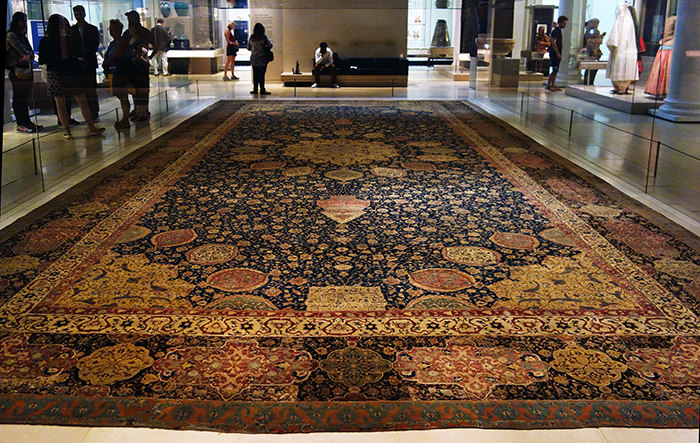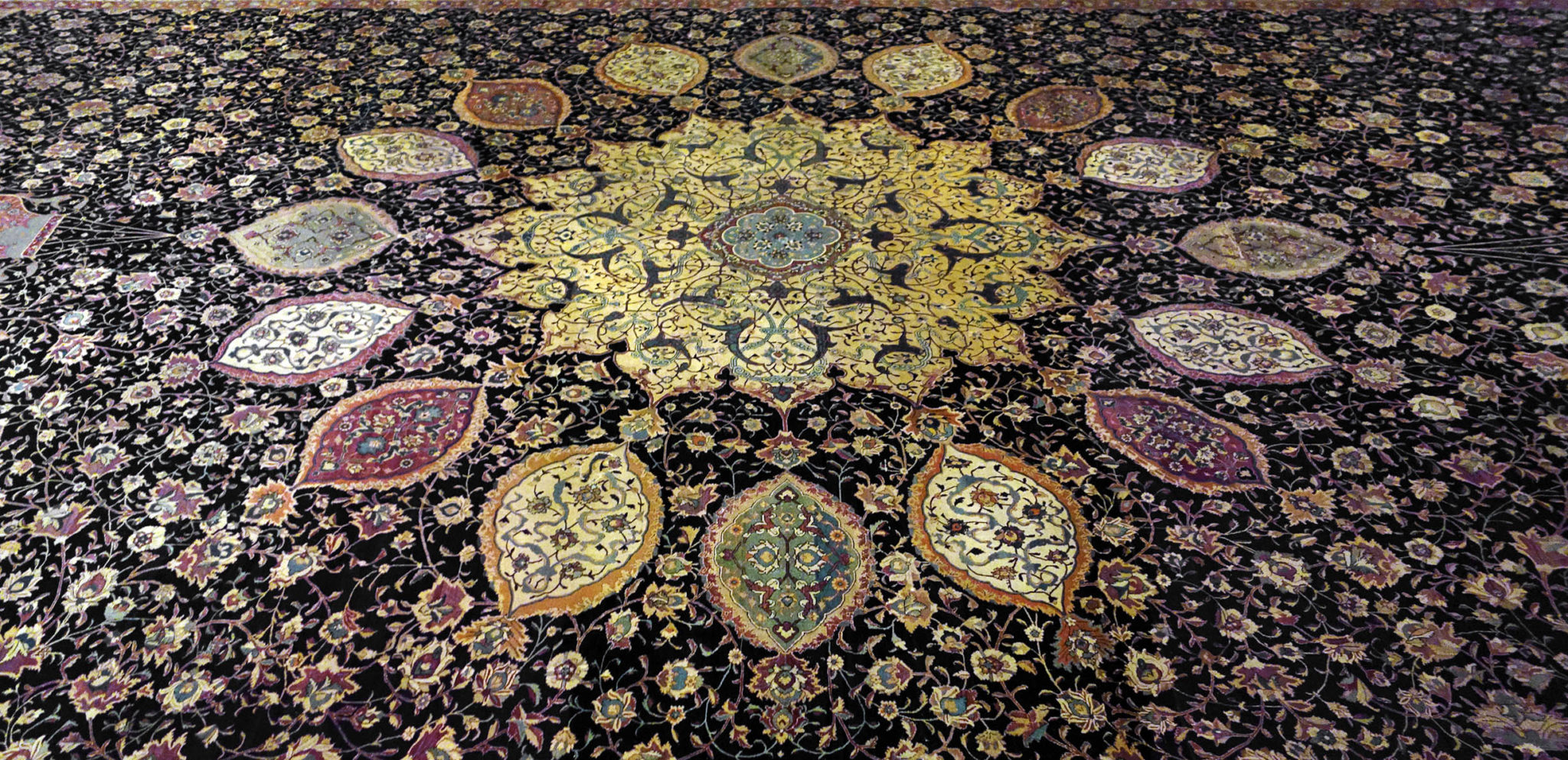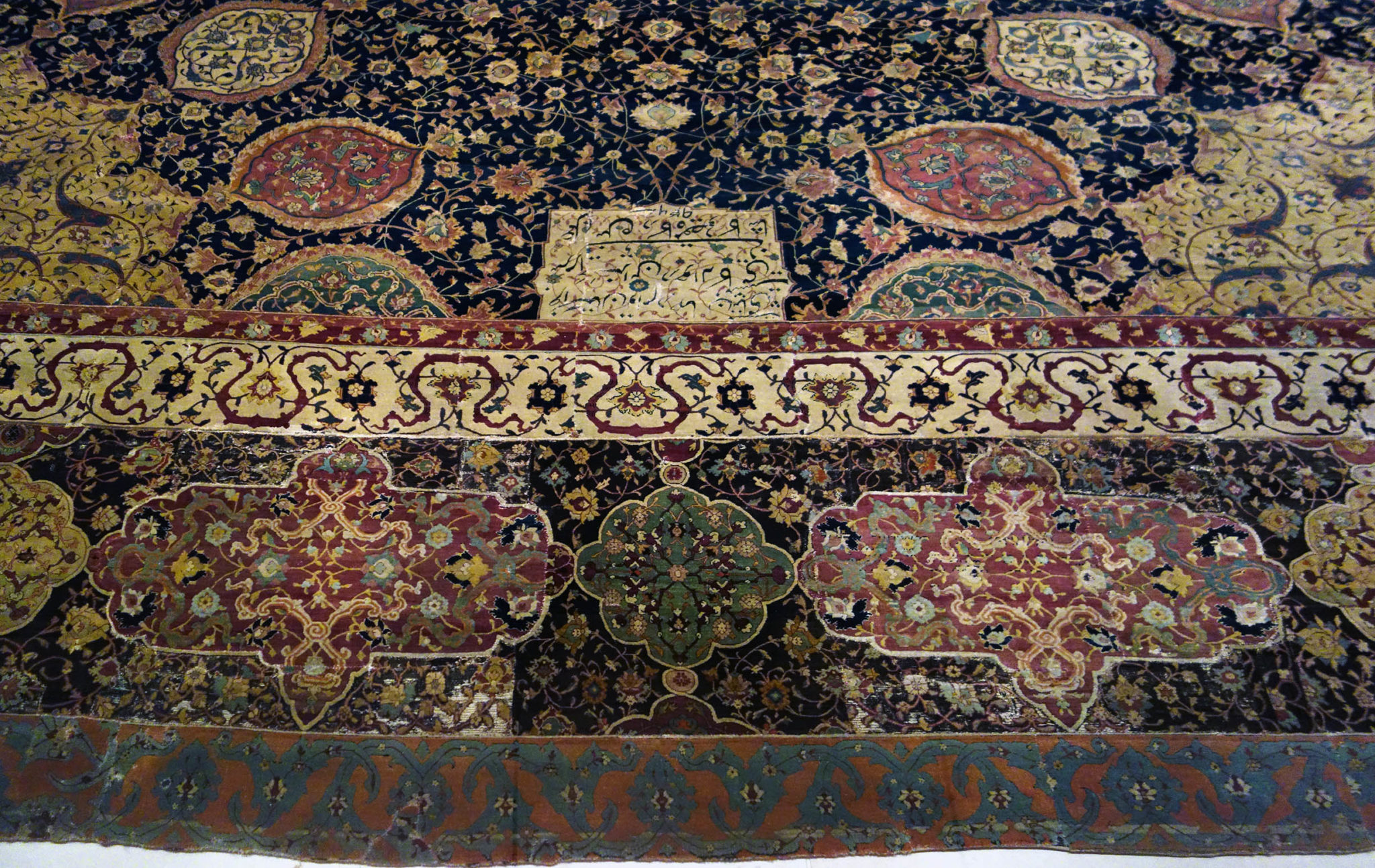Ardabil Carpet
ARDABIL CARPET
Safavid Dynasty
1539-1540 C.E.
Art Expression and What Can be Revealed
Varying techniques such as dyes, the tools, and machines used, along with the artist's choice of patterns and design are telling of the history of the carpet. As art styles develop in pre-Islamicate art, artworks from those times showcase the development in political, socioeconomic, and religious climates. The period when “The Ardabil Carpet” was crafted reveals not only the development in art but the patron Safi al-Din Ardabil who requested the piece to adorn in his throne. His influence and power stand the text the time as pieces from his shrine are preserved in museums for art histories to uncover more of the culture it came from. As result, artworks that survived over the centuries are able to create a story of what came before our time and what had existed.
“You may look at the social, political, spiritual, and/or economic significance of the work.” (D’Alleva, 44)
“… style communicates religious, social, political, and moral values through the. formal properties of the work of art.” (D’Alleva, 49)
The Patron of the Ardabil Carpet is Shaykh Safi Din Ardabili. The date of this carpet is 1539-40 C.E. The Ardabil Carpet is Persian. The Ardabil Carpet is extremely extravagant, it is meant to represent the life that was Shaykh Safi Din Ardabili. I believe that this was originally just used as a regular carpet, just like any other was used. The name of this carpet is after the person, which to me signifies the power that he had. Lines in the Ardabil Carpet create illusions with the color and the shapes. The lines switch from being harsh to smooth at some points throughout the carpet. The lines aren't emphasized throughout the painting. This is a three-dimensional work of art. There are ovals and circles all around the carpet which are geometric. There is light all over the carpet, there is tonal contrast. The dominant colors of the carpet are red, yellow, and blue. These are extremely bold colors. These colors are analogous which makes it look smooth. The surface of the carpet looks smooth and soft as if it was made of the most delicate of fabrics/ the carpet is flat but the shapes within have the extreme depth to them, the artist emphasizes the colors of the carpet, making sure that the richness of the colors come through. These features are shown through the shapes.
“ At first glance, the lamps appear to be of the same size. However, when looking closer the lamps are in fact disproportionate.”(Schwarts)
The Oldest Carpet

“The Ardabil Carpet” does similarly as it brings in influence from designs from scriptures like the “Shahnama” or otherwise known as “the book of kings” which served as a manual for new rulers. “The Shahnama” use of lush plants and bold greens and blue hues in its illustrations dates back to pre-Islamic art styles as artisans began to use dyes and inks popularly found in pomegranates and indigo plants. Details such as colors and styles can reveal the point in time the material was being used and why it was apparent in certain artworks as seen in Figure 4 and Figure 3 comparatively. In the case of the “ The Ardabil Carpet,” darker hues of blues, reds, yellows, and greens all come together to form an intricate yet delicate flower medallion design as seen in Figure 3. While in display in the Victoria and Albert Museum, tentative care is put towards the preservation of the illustrious hues of the thread and the entirety of the textile.
“It is lit for ten minutes on the hour and half-hour, in order to preserve its rich colors.(Victoria and Albert Museum)
(Figure 2: lamp design)
What is Revealed
Varying techniques such as dyes, the tools, and machines used, along with the artist's choice of patterns and design are telling of the history of the carpet. As art styles develop in pre-Islamicate art, artworks from those times showcase the development in political, socioeconomic, and religious climates. The period when “The Ardabil Carpet” was crafted reveals not only the development in art but the patron Safi al-Din Ardabil who requested the piece to adorn in his throne. His influence and power stand the text the time as pieces from his shrine are preserved in museums for art histories to uncover more of the culture it came from. As result, artworks that survived over the centuries are able to create a story of what came before our time and what had existed.
Art Detective
Growing up I often visited the Hsi Lai Temple located in Hacienda Heights, CA. My family and I would often visit the Temple for Sunday morning masque. Visiting the temple now, I am able to pick up on the design elements discussed in class. When inspecting the structure of the temple, eastern Asian design elements can be found throughout the building. Take for instance the double roofing technique where the roof of the building is split to create separate roofs on one structure to expand the space of the prayer hall. Other details such as the fencing done around the stairs and outdoor walkways are reminiscences of Islamicate designs. The curve edging of the roofing would be supported by dougong which are interlocking wooden brackets that reinforce the strength of the roof. The purpose of the dougong is to take in the shock from earthquakes and natural disasters if and when the building shakes. The temple itself is the focus of Buddhist worship and prayer.



This was really fun to read! I learned a lot about the Ardabil Carpet. I was really fascinated by the part that certain colors stood out more over time as they faded.
ReplyDeleteGood job overall! I liked the Art Detective section, the Hsi Lai Temple really does have similar architectural techniques that we have talked about in class! Pretty cool.
ReplyDeleteThe art detective section was nice, I liked the picture of the Temple.
ReplyDeleteWho knew a carpet could be so intricate. I enjoyed reading!
ReplyDeleteBeautiful artwork, you guys did it justice with the analysis!
ReplyDeleteI really enjoyed reading about the pattern on the rug.
ReplyDeleteWow, it is amazing how much information can be gathered from something as seemingly simple as a rug. Your use of pop out quotes also kept the reading interesting. Great work!
ReplyDeleteI loved reading how the Ardabil Carpet was created and the process!
ReplyDelete- Tahea Hossain
DeleteWho would have though there would be actual temples in California and i've not seen them?!?!? AMAZING
ReplyDeletethe inverse of colors of the Ardabil carpet are both beautiful and eye catching... it took me a second to process the color scheme in my head - jennah z
ReplyDeleteI really liked the analysis and organization of this blog post!
ReplyDeleteGreat job on the analysis! I really enjoyed reading.
ReplyDeleteThis comment has been removed by the author.
DeleteI think that being able to have this much intricate information on a carpet is awesome!!
ReplyDeleteI really enjoyed the art detective part. I didn't know that such a building existed in California, which makes me want to go visit it myself!
ReplyDeleteI didn't know there could be so much meaning behind a carpet, good job!
ReplyDeleteNot going to lie, this may be the biggest rug I’ve ever seen. Really interesting how much history can be incorporated into something so simple.
ReplyDeleteI really liked the carpet pictures and this blog post overall was really cool and interesting! Excellent job!
ReplyDelete-Hamida
DeleteI really like the dog chew toy on the floor.
ReplyDelete